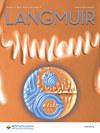Revealing the Interlayer Interaction Forces in 2D Graphene Materials by Graphene-Wrapped Nanoprobe
IF 3.7
2区 化学
Q2 CHEMISTRY, MULTIDISCIPLINARY
引用次数: 0
Abstract
Understanding the interlayer interaction between 2D layered structures is critical for the construction of various micro- and nanoscale functional devices. However, both the normal and the tangential interlayer interactions between 2D layered materials have rarely been studied simultaneously. In this work, an immersion and lift-up method is proposed to wrap a layer of graphene flakes onto a plasma-pretreated atomic force microscopy (AFM) nanoprobe for the measurements of interaction forces by AFM. The normal interactions (adhesion force and adhesion energy) and tangential interactions (friction force) between two different probes (Pt-coated probe and graphene-wrapped probe) and two different 2D graphene materials [graphene and graphene oxide (GO)] were systematically measured, respectively. The adhesion energies of Pt–GO, Pt–graphene, graphene–GO, and graphene–graphene were measured to be 0.72 ± 0.05, 0.41 ± 0.03, 0.19 ± 0.02, and 0.10 ± 0.02 J m–2, respectively. The graphene–graphene contact pair showed the lowest adhesion force (5.57 ± 1.03 nN) and adhesion energy (0.10 ± 0.02 J m–2), which was attributed to the strong covalent bonds and charge density distribution. The friction coefficients of Pt–GO, graphene–GO, Pt–graphene, and graphene–graphene were determined to be 0.38, 0.14, 0.054, and 0.013. The graphene–graphene tribo-pair exhibited a superlow friction state for a long time, which was attributed to incommensurate contact and weak van der Waals interactions. These findings provide a technical route to reveal the interlayer interactions of various 2D layered materials, which can be widely applied in microelectromechanical systems.

用石墨烯包裹的纳米探针揭示二维石墨烯材料中的层间相互作用力
了解二维层状结构之间的层间相互作用对于制造各种微米和纳米级功能器件至关重要。然而,人们很少同时研究二维层状材料之间的法向和切向层间相互作用。在这项工作中,我们提出了一种浸泡和提升方法,将一层石墨烯薄片包裹在等离子体预处理的原子力显微镜(AFM)纳米探针上,用原子力显微镜测量相互作用力。系统测量了两种不同探针(铂涂层探针和石墨烯包裹探针)与两种不同二维石墨烯材料(石墨烯和氧化石墨烯 (GO))之间的法向相互作用力(附着力和附着能)和切向相互作用力(摩擦力)。测得 Pt-GO、Pt-石墨烯、石墨烯-GO 和石墨烯-石墨烯的粘附能分别为 0.72 ± 0.05、0.41 ± 0.03、0.19 ± 0.02 和 0.10 ± 0.02 J m-2。石墨烯-石墨烯接触对显示出最低的粘附力(5.57 ± 1.03 nN)和粘附能(0.10 ± 0.02 J m-2),这归因于强共价键和电荷密度分布。铂-GO、石墨烯-GO、铂-石墨烯和石墨烯-石墨烯的摩擦系数分别为 0.38、0.14、0.054 和 0.013。石墨烯-石墨烯三元对长期呈现超低摩擦状态,这归因于不相称接触和微弱的范德华相互作用。这些发现为揭示各种二维层状材料的层间相互作用提供了一条技术路线,可广泛应用于微机电系统。
本文章由计算机程序翻译,如有差异,请以英文原文为准。
求助全文
约1分钟内获得全文
求助全文
来源期刊

Langmuir
化学-材料科学:综合
CiteScore
6.50
自引率
10.30%
发文量
1464
审稿时长
2.1 months
期刊介绍:
Langmuir is an interdisciplinary journal publishing articles in the following subject categories:
Colloids: surfactants and self-assembly, dispersions, emulsions, foams
Interfaces: adsorption, reactions, films, forces
Biological Interfaces: biocolloids, biomolecular and biomimetic materials
Materials: nano- and mesostructured materials, polymers, gels, liquid crystals
Electrochemistry: interfacial charge transfer, charge transport, electrocatalysis, electrokinetic phenomena, bioelectrochemistry
Devices and Applications: sensors, fluidics, patterning, catalysis, photonic crystals
However, when high-impact, original work is submitted that does not fit within the above categories, decisions to accept or decline such papers will be based on one criteria: What Would Irving Do?
Langmuir ranks #2 in citations out of 136 journals in the category of Physical Chemistry with 113,157 total citations. The journal received an Impact Factor of 4.384*.
This journal is also indexed in the categories of Materials Science (ranked #1) and Multidisciplinary Chemistry (ranked #5).
 求助内容:
求助内容: 应助结果提醒方式:
应助结果提醒方式:


